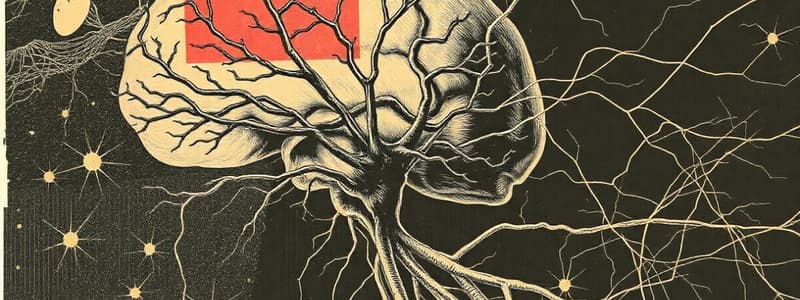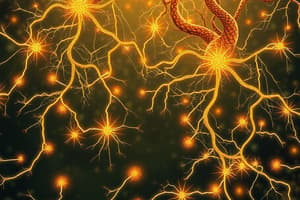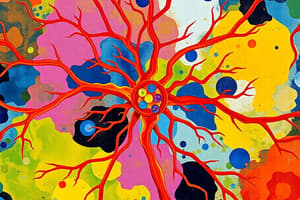Podcast
Questions and Answers
What are the three main steps of the nervous system's function?
What are the three main steps of the nervous system's function?
- Gather information, empathize, inform
- Stimulate reactions, interpret responses, mobilize actions
- Collect data, analyze outcomes, disseminate information
- Gather information, process information, inform the body (correct)
Which components are part of the Peripheral Nervous System?
Which components are part of the Peripheral Nervous System?
- Nerve bundles and glial cells
- Cerebellum and medulla
- Sensory receptors and sensory neurons (correct)
- Brain and spinal cord
What is the function of the myelin sheath?
What is the function of the myelin sheath?
- To collect impulses from other neurons
- To trigger neurotransmitter release
- To control the cell's activities
- To insulate and speed up electrical impulses along the axon (correct)
How does the brain determine the strength of a stimulus?
How does the brain determine the strength of a stimulus?
In a synapse, what does acetylcholine do after it diffuses across the synaptic gap?
In a synapse, what does acetylcholine do after it diffuses across the synaptic gap?
What role do Schwann cells play in the nervous system?
What role do Schwann cells play in the nervous system?
What substance do painkillers like aspirin inhibit to reduce sensitivity to pain?
What substance do painkillers like aspirin inhibit to reduce sensitivity to pain?
Which part of a neuron is primarily responsible for collecting impulses from other neurons?
Which part of a neuron is primarily responsible for collecting impulses from other neurons?
Flashcards are hidden until you start studying
Study Notes
### Nervous System
- The nervous system gathers information about the environment, processes and integrates the information, and then informs the necessary parts of the body.
- The central nervous system consists of the brain and spinal cord.
- The peripheral nervous system consists of sensory receptors, sensory neurons, motor neurons, and end plates.
### Neurons
- Neurons are nerve cells.
- Dendrites collect impulses from other neurons or sensory cells.
- The cell body is the control center of the neuron.
- A nerve impulse is an electrical impulse that travels along the axon.
- The myelin sheath insulates and protects the axon, speeding up the impulse.
- The axon carries impulses away from the cell body to other neurons, muscles, or glands.
- Schwann cells secrete the myelin sheath.
- Presynaptic knobs increase contact with the effector.
### Movement of Nerve Impulse
- Nerve impulses are either sent or not sent.
- A stimulus must reach a certain strength, called its threshold, to trigger an impulse.
- All nerve impulses are the same. The strength of a stimulus is determined by the frequency of nerve impulses per second. More impulses per second indicate a stronger stimulus.
- After an impulse passes, the process resets, ready for the next impulse.
### Synapses
- A synapse is the space between neurons.
- When an impulse arrives at the presynaptic knob, neurotransmitter vesicles move to the surface and release a transmitter substance, such as acetylcholine.
- Acetylcholine diffuses quickly across the synapse.
- It attaches to specific receptor sites on the post-synaptic swelling, triggering an impulse in the next neuron or stimulating an effector.
- The transmitter substance is then inactivated by an enzyme, such as cholinesterase.
- The inactive form diffuses back across the synapse and is reabsorbed into the presynaptic knob.
### Painkillers
- Prostaglandins, produced by damaged tissue, increase the sensitivity of pain receptors.
- Aspirin and ibuprofen inhibit the synthesis of prostaglandins.
### Neuron Types
- Sensory neurons: Carry impulses from receptors (e.g., sense organs) to the central nervous system. They are found in the dorsal root of the spinal cord, with their cell body located outside the central nervous system, at the end of a short branch along the length.
- Motor neurons: Carry impulses from the central nervous system to effector organs. They are found in the ventral root of the spinal cord, with their cell body located inside the central nervous system, at one end.
- Interneurons: Connect sensory to motor neurons within the central nervous system. They are found only in the central nervous system and have their cell body located inside the central nervous system at one end. Interneurons lack a myelin sheath.
Studying That Suits You
Use AI to generate personalized quizzes and flashcards to suit your learning preferences.




